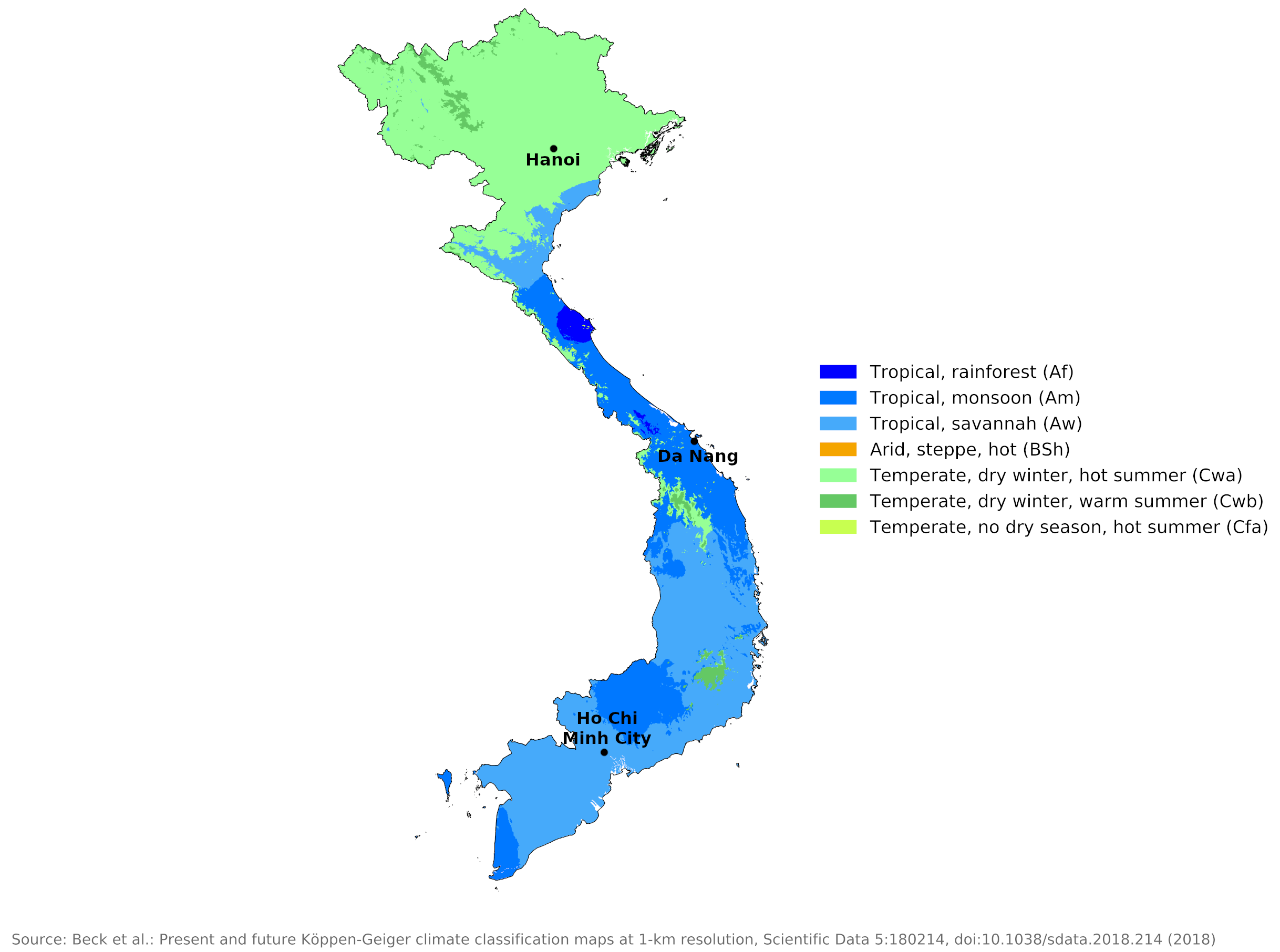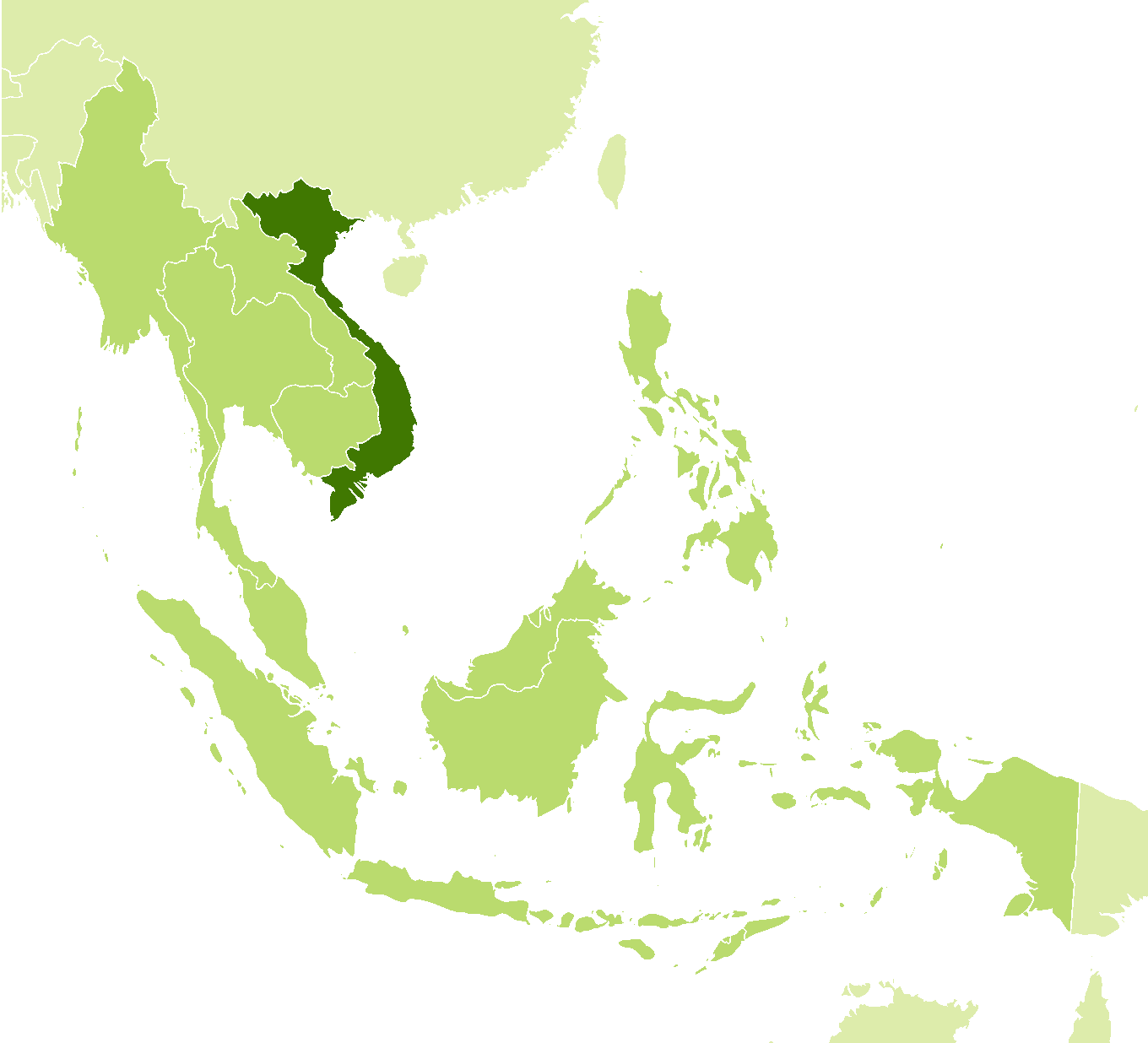The Climate of
Vietnam
 Tam Cốc, in Ninh Binh province
Tam Cốc, in Ninh Binh province
Climate Map
 Climate map of Vietnam
Climate map of Vietnam
What is the climate of Vietnam like?
Vietnam is a country in Southeast Asia, slightly larger than Great Britain and about half the size of the state of Texas. It extends between 9° and 23°N and lies entirely in the tropics. It has a long coastline on the Gulf of Tonkin and the South China Sea. On the land side it borders China in the north and Laos and Cambodia in the west.
There are significant highland areas rising to over 2,500 meters (8,000 feet), particularly in the northwest and central highlands facing the South China Sea. To the north around Hanoi and to the south around Ho Chi Minh City there are extensive lowland regions in the Red River Delta and Mekong Delta respectively. These two lowlands are home to a large part of the population.
Vietnam is entirely in the tropics. While there are variations in temperature depending on the season and elevation, the primary seasonal changes are characterized by fluctuations in rainfall. Vietnam has a tropical monsoon climate dominated by south to southeast winds from May to September and north to northeast winds from October to April. At the time of the transition from north to south monsoon there are changing winds twice a year.
Temperatures remain high year-round in the southern and central parts of Vietnam, but there is a distinctly cooler season in the north as the northern monsoon brings colder air from central China from time to time. The average annual temperature in Ho Chi Minh City is 27°C (81°F), compared to 23°C (74°F) in Hanoi. Although the central highlands are in the south, they are cooler due to their higher elevation. The average annual temperature in Da Lat in the highlands is 21°C (70°F). Frost and occasional snowfall occur only a few days a year on the highest mountains in the north. In southern Vietnam, the lowlands are sheltered from such outbursts of colder northern air and the dry season is warm to hot with plenty of sunshine.
| Climate data Ho Chi Minh City | |||||||||||||
|---|---|---|---|---|---|---|---|---|---|---|---|---|---|
| Month | Jan | Feb | Mar | Apr | May | Jun | Jul | Aug | Sep | Oct | Nov | Dec | Year |
| Average high °C (°F) | 31.6 (88.9) | 32.9 (91.2) | 33.9 (93.0) | 34.6 (94.3) | 34.0 (93.2) | 32.4 (90.3) | 32.0 (89.6) | 31.8 (89.2) | 31.3 (88.3) | 31.2 (88.2) | 31.0 (87.8) | 30.8 (87.4) | 32.3 (90.1) |
| Daily mean °C (°F) | 26.0 (78.8) | 26.8 (80.2) | 28.0 (82.4) | 29.2 (84.6) | 28.8 (83.8) | 27.8 (82.0) | 27.5 (81.5) | 27.4 (81.3) | 27.2 (81.0) | 27.0 (80.6) | 26.7 (80.1) | 26.0 (78.8) | 27.4 (81.3) |
| Average low °C (°F) | 21.1 (70.0) | 22.5 (72.5) | 24.4 (75.9) | 25.8 (78.4) | 25.2 (77.4) | 24.6 (76.3) | 24.3 (75.7) | 24.3 (75.7) | 24.4 (75.9) | 23.9 (75.0) | 22.8 (73.0) | 21.4 (70.5) | 23.7 (74.7) |
| Average precipitation mm (inches) | 13.8 (0.54) | 4.1 (0.16) | 10.5 (0.41) | 50.4 (1.98) | 218.4 (8.60) | 311.7 (12.27) | 293.7 (11.56) | 269.8 (10.62) | 327.1 (12.88) | 266.7 (10.50) | 116.5 (4.59) | 48.3 (1.90) | 1,931 (76.01) |
| Source: Vietnam Institute for Building Science and Technology | |||||||||||||
| Climate data for Hanoi | |||||||||||||
|---|---|---|---|---|---|---|---|---|---|---|---|---|---|
| Month | Jan | Feb | Mar | Apr | May | Jun | Jul | Aug | Sep | Oct | Nov | Dec | Year |
| Average high °C (°F) | 19.7 (67.5) | 20.1 (68.2) | 22.9 (73.2) | 27.2 (81.0) | 31.4 (88.5) | 32.9 (91.2) | 33.1 (91.6) | 32.3 (90.1) | 31.2 (88.2) | 28.8 (83.8) | 25.3 (77.5) | 22.0 (71.6) | 27.2 (81.0) |
| Daily mean °C (°F) | 16.4 (61.5) | 17.2 (63.0) | 20.0 (68.0) | 23.9 (75.0) | 27.4 (81.3) | 28.9 (84.0) | 29.2 (84.6) | 28.6 (83.5) | 27.5 (81.5) | 24.9 (76.8) | 21.5 (70.7) | 18.2 (64.8) | 23.6 (74.5) |
| Average low °C (°F) | 14.3 (57.7) | 15.3 (59.5) | 18.1 (64.6) | 21.7 (71.1) | 24.6 (76.3) | 26.1 (79.0) | 26.3 (79.3) | 26.0 (78.8) | 24.9 (76.8) | 22.3 (72.1) | 18.9 (66.0) | 15.6 (60.1) | 21.2 (70.2) |
| Average precipitation mm (inches) | 18 (0.7) | 19 (0.7) | 34 (1.3) | 105 (4.1) | 165 (6.5) | 266 (10.5) | 253 (10.0) | 274 (10.8) | 243 (9.6) | 156 (6.1) | 59 (2.3) | 20 (0.8) | 1,612 (63.4) |
| Source: Vietnam Institute for Building Science and Technology | |||||||||||||
During the southern monsoon there is a single rainy season. During the rest of the year it rains rarely and lightly. In the north, the rainy season extends from mid-April to mid-October; The city of Hanoi has an average annual rainfall of 1,700 millimeters (68 inches), and in the mountains annual rainfall sometimes exceeds 4,000 millimeters (160 inches). In the south, the rainy season extends from early May to November, with annual rainfall averaging about 2,000 millimeters (79 inches) in the lowland regions.
On the coast and in those parts of the central highlands that face northeast, the season with the highest rainfall is between September and January (see Da Nang climate). This area often receives heavy rain from typhoons or severe tropical storms that develop in the western Pacific at this time of year. This is also a period with lots of clouds and frequent drizzle (locally called 'crachin'). In northern Vietnam, during the northeast monsoon season, there are more cloudy days with occasional light rain. The south of the country is rather dry and sunny at this time.
| Climate data for Da Nang | |||||||||||||
|---|---|---|---|---|---|---|---|---|---|---|---|---|---|
| Month | Jan | Feb | Mar | Apr | May | Jun | Jul | Aug | Sep | Oct | Nov | Dec | Year |
| Average high °C (°F) | 25.1 (77.2) | 26.1 (79.0) | 28.5 (83.3) | 31.0 (87.8) | 33.1 (91.6) | 34.2 (93.6) | 34.4 (93.9) | 33.9 (93.0) | 31.6 (88.9) | 29.3 (84.7) | 27.1 (80.8) | 24.9 (76.8) | 29.9 (85.8) |
| Daily mean °C (°F) | 21.5 (70.7) | 22.3 (72.1) | 24.2 (75.6) | 26.4 (79.5) | 28.3 (82.9) | 29.2 (84.6) | 29.3 (84.7) | 29.0 (84.2) | 27.5 (81.5) | 25.9 (78.6) | 24.1 (75.4) | 22.1 (71.8) | 25.8 (78.4) |
| Average low °C (°F) | 19.1 (66.4) | 20.0 (68.0) | 21.5 (70.7) | 23.5 (74.3) | 24.9 (76.8) | 25.6 (78.1) | 25.4 (77.7) | 25.4 (77.7) | 24.3 (75.7) | 23.3 (73.9) | 21.8 (71.2) | 19.7 (67.5) | 22.9 (73.2) |
| Average precipitation mm (inches) | 85 (3.3) | 25 (1.0) | 20 (0.8) | 35 (1.4) | 84 (3.3) | 90 (3.5) | 87 (3.4) | 117 (4.6) | 312 (12.3) | 650 (25.6) | 432 (17.0) | 216 (8.5) | 2,153 (84.8) |
| Source: Vietnam Institute for Building Science and Technology | |||||||||||||
The weather in Vietnam is quite muggy and oppressive during the rainy season and the humidity is high at this time. On the coast and in the hills, the frequent clouds and high humidity together with the lack of sunshine make this time of year quite uncomfortable, despite the reduction in temperatures with altitude.
References
- E. A. Pearce, Charles Gordon Smith, (1990) The Hutchinson World Weather Guide, John Murray Press. ISBN 1859863426
- Timothy L. Gall, (ed.), (2003), Worldmark Encyclopedia of the Nations, Eleventh Edition, Thomson Gale
- Federal Research Division, Library of Congress, (1989), Vietnam: a country study. Claitor's Pub. Division.
- Hugh Chisholm, (ed.), (1911), Encyclopædia Britannica, Eleventh edition, Cambridge University Press
The Climate of
Vietnam

In summary:
Vietnam has a tropical climate, and temperatures remain high around the year. The average annual temperature in Ho Chi Minh City is 27°C (81°F), compared with 23°C (74°F) in Hanoi. In the north there is a definite cooler season between October and March. In the south of Vietnam, the lowlands are sheltered from any outbreaks of cold, northerly air and the dry season is warm to hot with much sunshine.
Over most of Vietnam there is a single rainy season at the time of the south monsoon between May and September, although the central coastal region gets maximum rainfall between September and January. Average annual rainfall ranges from 1600 mm (64 in) in Hanoi to more than 4000 mm (160 in) in the mountains. Typhoons strike the central coastal region between July and November.